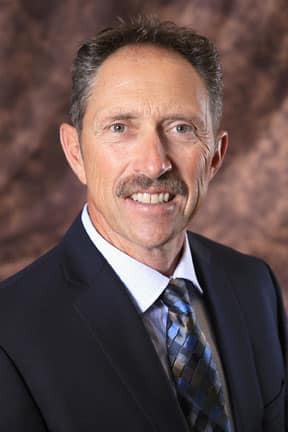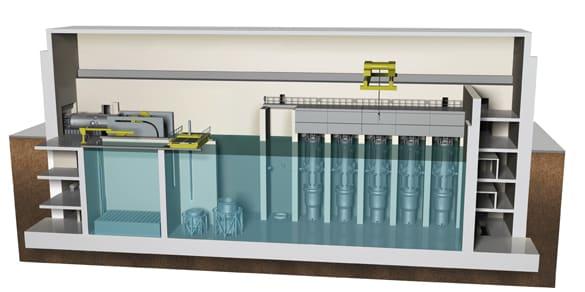 Steve Cummins
Steve CumminsKIRSTEN LASKEY
Los Alamos Daily Post
kirsten@ladailypost.com
The Carbon Free Power Project has been ushered into the next phase.
The Board of Public Utilities recommended approval and the Los Alamos County passed a resolution to enter the licensing period phase 1 with Utah Associated Municipal Power Systems (UAMPS) during a special joint meeting held April 10.
This is a step forward toward ultimately receiving some of the county’s electric power from a small nuclear reactor facility called the Carbon Free Power Project that would be located in Idaho. The county is currently subscribed to receive eight megawatts of power from the facility with a cost target of $65 a megawatt hour (MWh). The facility would have 12 units, grossing 50 megawatts per unit. Currently, of the 600 megawatts that plant would generate, 183 megawatts are currently subscribed.
There is still a way to go before the plant is constructed and generating electricity, however; two other phases will need to be considered for approval and there are three off-ramps for the county to exit should it conclude the project is no longer viable.
Deputy Utilities Manager of the Department of Public Utilities Steve Cummins said the major goals before the first off-ramp, which will be through March 2019, is for UAMPS to seek additional funds from the Department of Energy (DOE) and gather more subscriptions (ownership shares) for power that would be generated through the nuclear facility using the small modular reactors. Furthermore, Cummins said another objective is to determine a contracting mechanism in which DOE and the Department of Defense facilities in the region could receive power from the project.
Achieving the goals for this next year looks promising. Moreover, Cummins said DOE has shown an interest in purchasing two of the units through a Joint Use Module Plant (JUMP) contract. Plus, more than $300 million has been committed to the project through a grant that was cost shared between DOE and NuScale.
There are challenges though. Cummins said federal facilities cannot invest in the project without a guarantee the federal government will see a return. For instance, while Los Alamos National Laboratory (LANL) participated in the project’s initial study phase siting agreement, it cannot participate in the developmental phases without the guarantee of receiving power from the project at a negotiated amount.
Still, “They’re very interested in the power and they’re very interested in participating,” Cummins said.
The federal government’s participation through cost sharing and subscription is key to the project but more importantly is the Department of Energy’s commitment to seeing this new innovative small modular reactor technology through commercial development.
Cummins said if the JUMP contract is signed and DOE continues to cost share through the licensing phase of the project, then “UAMPS believes the cost of power might be less than the $65 per MWh.” In fact, he said, UAMPS has suggested that the cost might be $55 per MWh.
While Cummins said DPU customers will not see a decrease in their utility rates, the $65 rate, which includes the county’ portion of the debt service on the nuclear facility, is comparable to what the county paid during the debt service period for its hydroelectric plants and its share of the San Juan Generating station.
Cummins pointed out that the Carbon Free Power Project option is only 3.5 percent higher than the option of installing solar with storage, based on the target price of $65/MWh according to the county’s Integrated Resource Plan (IRP). A third-party expert was contracted by DPU to weigh the county’s future energy resource options, looking at risk, cost, and availability. Completed in August of 2017, the results of this assessment are compiled in the IRP which is available on the county’s website: https://rebrand.ly/DPU-IRP.
In 2015, when the county agreed to enter into the initial study phase siting agreement for the Carbon Free Power Project, $145,540 was approved by the county and LANL, of which LANL contributed 80 percent. By entering into the next phase or the licensing phase, the county’s maximum cost exposure before the first off-ramp in 12 months is $80,000.
If there is no additional DOE grant money awarded to the project and no additional subscriptions, more than likely the UAMPS subscribers will decide to terminate the project. All the money spent over the period of April 2018 through March 2019 will be fully reimbursed. If just Los Alamos County decides to exit the project, then its maximum exposure would be the $80,000, Cummins said. However, the County could decide to sell its eight megawatts to another interested party that would like to proceed with the project.
While DPU is pursuing this Carbon Free Power Project, it is not ignoring other energy resource options. In fact, Cummins said next year an additional one megawatt of solar will be added adjacent to the County’s existing solar array near the eco station.
DPU Public Relations Manager Julie Williams-Hill added it is important to have a diverse energy portfolio.
“We want to diversify our power generation portfolio so it can absorb the fluctuations in energy output and cost for each resource over time,” she said.
DPU is pursuing the Carbon Free Power Project because the county has a goal to be carbon free by 2040. Eight megawatts of baseload nuclear power combined with the county’s 26 megawatts of hydroelectric power, two megawatts of solar power near the eco station, plus an increase in customer-owned roof-top solar is believed to help the county realize this end-goal.
Los Alamos became involved in the small nuclear modular reactor project through its membership with UAMPS.
Cummins explained during the joint April 10 meeting, that the county joined UAMPS in 2014 to help navigate the power industry, which is changing so fast. UAMPS is made up of 46 municipal power entities many of which are smaller than Los Alamos.
Cummins added the “advantage of these municipal-owned utilities working together to solve energy demands while meeting customers’ expectations for clean energy is a great benefit to all of our communities.”
Thirty-two UAMPS members are participating in the carbon free power project.
As a result, Cummins said UAMPS members make up more than 25 percent of the capacity of the nuclear plant by partnering together. Los Alamos County alone only represents 1.3 percent of the plant capacity which demonstrates the difficulty for small utilities in developing new resources.
In addition to UAMPS, the other parties involved in the Carbon Free Power Project include Fluor, a global engineering and construction company that is the parent company of NuScale, the developer of the SMR technology. UAMPS is contracting with Fluor to construct the nuclear facility, Cummins said. Also, Energy Northwest, a public power joint operating agency like UAMPS, and the owner and operator of the Columbia Generating Station, a nuclear power plant in Washington State. UAMPS will contract with Energy Northwest to operate the new facility. Cummins explained that of course DOE is a huge stakeholder in the project too. Through cost sharing and through additional subscriptions, DOE hopes to serve the power demands of federal agencies’ facilities with clean, reliable energy.
During the April 10 meeting, the public weighed in on the project. Mike Dempsey said, “I am totally for this project. It’s forward-thinking; it’s carbon free or low carbon. It needs to be done. I see nothing wrong. It makes me proud that [the county] can be visionary like this.”
He added, ““There’s no waiting around anymore.… I want robust, reliable baseload energy for my house in White Rock and that’s what nuclear power brings us.”
Phil Gursky said, he is not opposed to the project in concept, but he is concerned about the time schedule and availability of power when the County needs it. The schedules do not seem to match up to the closing of the San Juan coal-fired plant, which currently supplies some of the County’s power.
Another member of public, Mark Jones said he shares the enthusiasm for the project, but felt the risks and costs of the program should be taken on by DOE or a venture capital firm, not the County. He pointed out there are uncertainties about the project and while there are off ramps available to the County, he said the $80,000 that would be reimbursed does not cover the total investment the County has made to the project such as staff hours.
 A rendering of the NuScale reactor facility. Image Provided by NuScale Power, LLC
A rendering of the NuScale reactor facility. Image Provided by NuScale Power, LLC
